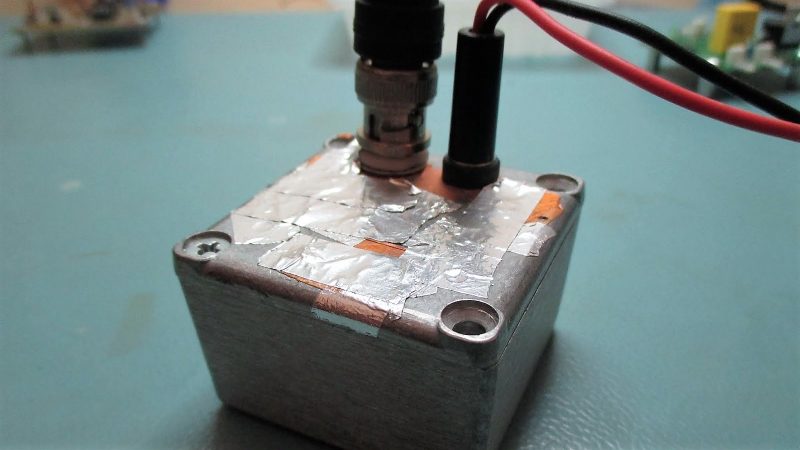When the topic is radiation detection, thoughts turn naturally to the venerable Geiger-Müller tube. It’s been around for ages, Russian surplus tubes are available for next to nothing, and it’s easy to use. But as a vacuum tube it can be somewhat delicate, and the high voltages needed to run it can be a little on the risky side.
Luckily, there are other ways to see what’s going on in the radioactive world, like this semiconductor radiation detector. [Robert Gawron] built it as a proof-of-concept after having built a few G-M tube detectors before. His solid-state design relies on a reverse-biased photodiode conducting when ionizing radiation hits the P-N junction. The tiny signal is amplified by a pair of low-noise op-amps and output to a BNC connector. The sensor’s analog output is sent to an oscilloscope whose trigger out is connected to a Nucleo board for data acquisition. The Nucleo is in turn connected to a Raspberry Pi for totalizing and logging. It’s a complicated chain, but the sensor appears to work, even detecting alpha emissions from thoriated TIG electrodes, a feat we haven’t been able to replicate with our G-M tube counter.
[Robert]’s solid-state detector might not be optimal, but it has promise. And we have seen PIN diodes used as radiation detectors before, too.
[via Dangerous Prototypes]
















I believe the cheap keychain Nukealert consists of a scintillator and a photosensor an ATtiny to count the flashes detected by the photosensor a piezo speaket to beep pulses at different rates to indicate 10 radiation thresholds. 10year lithium cell.
I got one back in fire/EMS days when I went to a haz-mat school but they sometimes pop up on ebay if you want to scavenge the scintillator and sensor..
The NukAlert uses a CdS photocell bonded to a scintillator. It can’t detect flashes, but rather is a relatively slow integrator of signal from ionizing radiation. The beep rate is related to the conductivity of the CdS cell.
This is another cool radiation detector called a spark detector which is quite simple in construction. https://www.youtube.com/watch?v=-8GlzUjYazs
There shouldn’t be any problem detecting emissions from thoriated TIG tungstens with a Geiger Muller tube. I am building a counter now,using thoriated tungstens for testing and they work fine.
BobH,
It’s unlikely you’re seeing the alphas from the Thorium unless you have a mica or similar thin-windowed tube. The cheap glass and metal tubes can’t see alphas. But they quite happily see the large family of gammas from Thorium daughter decays.
My cheap glass Geiger tube sees about 15 cpm from a thoriated TIG rod, over a 20 cpm background, and it’s blind to alphas.
You see the same with the “alpha emitter” 241-Am, because of the 60 keV gamma it also releases.
I was wondering about that.
ObAppNote: Maxim published a datasheet describing this in 2003. They describe some of the reasons behind component choices, and the importance of diode capacitance: https://www.maximintegrated.com/en/app-notes/index.mvp/id/2236 . They also use a more rationally thought-out front end than this design, not subject to drift and temperature-sensitive bias that this one is.
Also have a look at First Sensor’s sensor technologies: https://www.first-sensor.com/cms/upload/datasheets/gamma-ray-detection.pdf These ones are purpose-designed for low-energy gamma & x-ray detection, and are a huge leap in performance over jellybean photodiodes like the commonly-used BPW34. (Though, sadly, First Sensor’s detector is also about 100x the cost)
It there a reason why a photodiode is used instead of a diode with a much larger surface area like a photovoltaic cell.
Like pretty much everyone else trying this, [Robert] uses a BPW34, which is a large-area (7 mm^2) photodetector (or photodiode, or photovoltaic cell — all pretty much the same thing). It is almost unique in that it has a large area, but very low leakage current, and it is very inexpensive and readily available.
Like most photodiodes, though, even though it has a large area, its depletion region is quite thin so the detection volume is still very small compared to (say) a block of scintillator material. Photons more energetic than around 30 keV tend to sail on through without interacting.
First Sensor’s detector is still “just” a photodiode, but it is both larger (100 mm^2) and with a thicker depletion region. It is also manufactured to have very low dark current. So as photodiodes go, it’s far superior to the repurposed light detectors like the BPW34. They also offer a version with a scintillator bonded to it, to extend the sensitivity to higher energies.
You *can* just glue a sheet of scintillator (say, Lanex Fast) onto any old solar cell and measure the current it produces. This works and actually makes a reasonable large-area survey meter (e.g., to look for leaks in shielding). However, you’ll never see single photons because the capacitance it way too high (damping the teeny pulse), and it’s not sensitive to very low dose rates because of leakage (dark) current.
How about a low cost Radon Detector build? There is not much hard radiation to worry about on a day to day basis, but Radon is seeping into basements in may parts of the country.
You can’t really detect radon directly from air because of the low concentrations (and if you have enough that you can, there’s no need to worry about it, at that point you’d be dead anyway :P)
You use something like activated carbon to filter a known volume of air and you then measure whatever got stuck on on the activated carbon. Even then the sample has to be measured by fairly sensitive detectors and everything has to be inside a shielded chamber to block the natural background.
“analog output is sent to an oscilloscope whose trigger out” … that is a very expensive comparator :)
Elektor electronics build a similar device that tested to be just as accurate as any with a russian tube in them.
https://www.elektormagazine.com/labs/improved-radiation-meter-110538